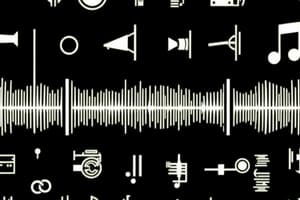Podcast
Questions and Answers
What is the main difference between word-formation and inflection?
What is the main difference between word-formation and inflection?
- Inflection creates new words, while word-formation changes the form of a word.
- Inflection is more predictable than word-formation. (correct)
- Word-formation is only used in open systems, while inflection is only used in closed systems.
- Word-formation creates new words, while inflection changes the form of a word. (correct)
What kind of morphological process is used to express plurality in Japanese?
What kind of morphological process is used to express plurality in Japanese?
- Both inflection and word-formation are used.
- Word-formation (correct)
- Inflection
- Neither, Japanese doesn't have a grammatical category of plurality.
In the Swahili example, which system of grammatical expression is used for 'my'?
In the Swahili example, which system of grammatical expression is used for 'my'?
- Word-formation
- Grammatical
- Lexical (correct)
- Inflection
What is the best example of a morpheme in the content?
What is the best example of a morpheme in the content?
Which of the following statements best describes the relationship between morphemes and morphs?
Which of the following statements best describes the relationship between morphemes and morphs?
What term refers to words that are identical in both pronunciation and spelling?
What term refers to words that are identical in both pronunciation and spelling?
Which of the following examples represents homophones?
Which of the following examples represents homophones?
What do we call the smallest units of language that carry meaning?
What do we call the smallest units of language that carry meaning?
Which example illustrates a homograph?
Which example illustrates a homograph?
Why do readers or hearers need context when interpreting homonyms?
Why do readers or hearers need context when interpreting homonyms?
What does 'allophones realized in complementary distribution' refer to in phonology?
What does 'allophones realized in complementary distribution' refer to in phonology?
What is the primary focus of morphology in linguistics?
What is the primary focus of morphology in linguistics?
Which example demonstrates a phonological difference between English and German?
Which example demonstrates a phonological difference between English and German?
Which of the following pairs of words demonstrates the concept of neutralization of contrasts, as exemplified by 'happy' and 'react'?
Which of the following pairs of words demonstrates the concept of neutralization of contrasts, as exemplified by 'happy' and 'react'?
What is the characteristic feature of American English that differentiates it from other varieties in terms of consonant contrasts?
What is the characteristic feature of American English that differentiates it from other varieties in terms of consonant contrasts?
In the provided text, which of the following is NOT presented as a result of the neutralization of contrasts?
In the provided text, which of the following is NOT presented as a result of the neutralization of contrasts?
What is the primary function of a sound type in a language?
What is the primary function of a sound type in a language?
What is the term used in the text to describe the phenomenon of sounds becoming indistinguishable in certain positions?
What is the term used in the text to describe the phenomenon of sounds becoming indistinguishable in certain positions?
Which of the following is NOT a characteristic of the neutralisation of contrasts?
Which of the following is NOT a characteristic of the neutralisation of contrasts?
Based on the text, how would you describe the final devoicing rule in German?
Based on the text, how would you describe the final devoicing rule in German?
Which of these examples from the text demonstrates the lack of contrast, or the fact that words are not always phonetically distinct?
Which of these examples from the text demonstrates the lack of contrast, or the fact that words are not always phonetically distinct?
Which of the following words is a morphological unit based on the provided content?
Which of the following words is a morphological unit based on the provided content?
Based on the content, what is the morphological status of the sound sequence "in" in the word "injustice"?
Based on the content, what is the morphological status of the sound sequence "in" in the word "injustice"?
What is the primary difference between "lexical morphemes" and "grammatical morphemes" according to the content?
What is the primary difference between "lexical morphemes" and "grammatical morphemes" according to the content?
What is the morphological status of the sound sequence "in" in the word "independent"?
What is the morphological status of the sound sequence "in" in the word "independent"?
Which of the following words is NOT an example of a lexical morpheme?
Which of the following words is NOT an example of a lexical morpheme?
Based on the provided content, which of the following is NOT a characteristic of bound morphemes?
Based on the provided content, which of the following is NOT a characteristic of bound morphemes?
Which of the following is the best example of a derivational affix, based on the information provided?
Which of the following is the best example of a derivational affix, based on the information provided?
According to the provided content, what is the morphological status of the sound sequence "in" in the word "inch"?
According to the provided content, what is the morphological status of the sound sequence "in" in the word "inch"?
Which of the following options would be considered a lexical element, according to the text?
Which of the following options would be considered a lexical element, according to the text?
What does the text suggest about the relationship between linguistic expressions and their grammatical features?
What does the text suggest about the relationship between linguistic expressions and their grammatical features?
What distinguishes a grammatical category from a lexical category?
What distinguishes a grammatical category from a lexical category?
Which of the following options is an example of a grammatical feature that can have implications for other choices in a sentence?
Which of the following options is an example of a grammatical feature that can have implications for other choices in a sentence?
The text mentions that expressing contrasts grammatically rather than lexically is an arbitrary feature of language. What does this imply?
The text mentions that expressing contrasts grammatically rather than lexically is an arbitrary feature of language. What does this imply?
Based on the text, how could we understand the difference between a morphological category and a lexical category?
Based on the text, how could we understand the difference between a morphological category and a lexical category?
What does the text suggest about the relationship between lexical and grammatical elements in language?
What does the text suggest about the relationship between lexical and grammatical elements in language?
The text highlights that expressing physical properties through grammatical means is common in Bantu languages. Which of the following is a plausible reason why this might be the case?
The text highlights that expressing physical properties through grammatical means is common in Bantu languages. Which of the following is a plausible reason why this might be the case?
Flashcards
Homophones
Homophones
Words that sound the same but have different meanings.
Homographs
Homographs
Words that are spelled the same but have different meanings or pronunciations.
Homonyms
Homonyms
Words that are both homophones and homographs; they sound and are spelled the same with different meanings.
Morpheme
Morpheme
Signup and view all the flashcards
Phoneme
Phoneme
Signup and view all the flashcards
Allophone
Allophone
Signup and view all the flashcards
Phonological differences
Phonological differences
Signup and view all the flashcards
Syllable structure
Syllable structure
Signup and view all the flashcards
Lexical Morphology
Lexical Morphology
Signup and view all the flashcards
Grammatical Morphology
Grammatical Morphology
Signup and view all the flashcards
Morphs
Morphs
Signup and view all the flashcards
Formality in Japanese Verbs
Formality in Japanese Verbs
Signup and view all the flashcards
Neutralisation of contrasts
Neutralisation of contrasts
Signup and view all the flashcards
T-flapping
T-flapping
Signup and view all the flashcards
Auslautverhärtung
Auslautverhärtung
Signup and view all the flashcards
Fortis/lenis distinction
Fortis/lenis distinction
Signup and view all the flashcards
Unstressed vowel pronunciation
Unstressed vowel pronunciation
Signup and view all the flashcards
Voiceless sounds
Voiceless sounds
Signup and view all the flashcards
Minimal pairs
Minimal pairs
Signup and view all the flashcards
Lack of contrast in sounds
Lack of contrast in sounds
Signup and view all the flashcards
Universal Declaration of Human Rights
Universal Declaration of Human Rights
Signup and view all the flashcards
Lexical elements
Lexical elements
Signup and view all the flashcards
Grammatical elements
Grammatical elements
Signup and view all the flashcards
Closed system in grammar
Closed system in grammar
Signup and view all the flashcards
Physical properties in language
Physical properties in language
Signup and view all the flashcards
Vocabulary size
Vocabulary size
Signup and view all the flashcards
Implications of grammatical choices
Implications of grammatical choices
Signup and view all the flashcards
Marker for singular and plural
Marker for singular and plural
Signup and view all the flashcards
Free morpheme
Free morpheme
Signup and view all the flashcards
Bound morpheme
Bound morpheme
Signup and view all the flashcards
Derivational morpheme
Derivational morpheme
Signup and view all the flashcards
Inflectional morpheme
Inflectional morpheme
Signup and view all the flashcards
Lexical meaning
Lexical meaning
Signup and view all the flashcards
Grammatical meaning
Grammatical meaning
Signup and view all the flashcards
Morphological status
Morphological status
Signup and view all the flashcards
Study Notes
Phonology
- Phonology studies the sound system of a language
- Neutralization of contrasts occurs when distinct sounds become indistinguishable in certain environments
- In some cases, the pronunciation of letters might be difficult to categorize as either /i:/ or /ɪ/ based on context (e.g., happy, react).
- Unstressed vowels in final positions or before other vowels are neither long as in "read" nor open as in "rid"; they sound like an intermediate vowel [ɪ].
- In American English, the contrast between /t/ and /d/ is sometimes neutralized in certain phonetic environments: (like pairs of latter-ladder or time-dime.
- German and Slavic languages demonstrate final devoicing, meaning voiceless sounds are used at the end of syllables irrespective of the root (example: Rat [t] – Rad [t])
- Homophones are words that have the same pronunciation but different meanings (e.g., seal₁ 'stamp' and seal₂ 'marine mammal').
- Homographs are words that have the same spelling but different pronunciations and meanings (e.g., bow/bəʊ/ - bow/baʊ/).
- Homonyms are words with the same spelling and pronunciation but different meanings. To differentiate between homonyms, one needs to consider the context.
- Different accents exist in English and German (and other languages), creating phonological diversification in their respective language families.
- Phonetics and phonology study the functional status of sounds in the language system, utilizing minimal pairs to understand sounds.
- Allophones are sounds that have complementary distribution, meaning they appear only in specific environments.
Morphology
- Morphology studies the internal structure of words.
- Words are broken down into morphemes, which are units of language that carry meaning.
- Morphemes are the basic building blocks of words.
- Morphemes can be lexical (meaning carrying content words, like simple nouns, e.g., "book") or grammatical (function words, like the, a, and).
- Lexical morphemes are open-class items; additions happen frequently.
- Grammatical morphemes are closed class; additions are rare
- Morphological analysis can be applied to lexical (words as abstract elements) and grammatical elements.
- The different morphological processes like word-formation and inflection result in the formation of word-forms and lexemes
- Word-formation involves creating new words, creating a new lexical item (e.g., un-reliable).
- Inflection alters existing words (e.g., cat-cats).
- Morphemes exist as abstract elements in langue, but are physically realised as morphs.
- Morphs are the actual sequences of sounds used to produce morphemes.
- Allomorphs are different phonetic forms of the same morpheme.
- Allomorphs have phonologically conditioned realizations.
- The various processes of word formation and inflection create a structured vocabulary (including words, lexemes, grammatical categories, and/or allomorphs).
Studying That Suits You
Use AI to generate personalized quizzes and flashcards to suit your learning preferences.




